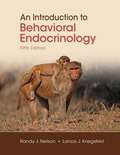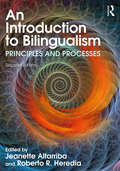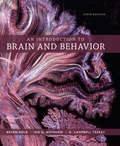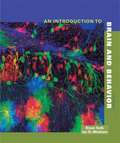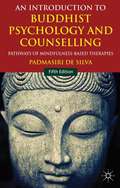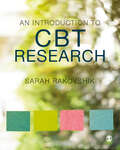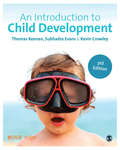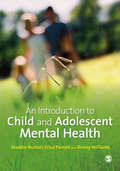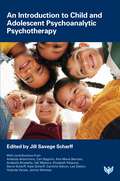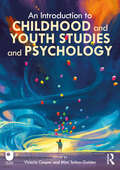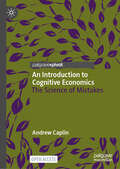- Table View
- List View
An Introduction to Behavioral Endocrinology, Fifth Edition
by Randy J. Nelson Lance J. KriegsfeldAn Introduction to Behavioral Endocrinology, Fifth Edition retains all of the features of the bestselling prior editions, and provides an updated, integrated presentation of the study of hormone-behavior-brain interactions.
An Introduction to Bilingualism: Principles and Processes
by Jeanette Altarriba and Roberto R. HerediaThe study of bilingualism and all of its aspects – from theory and models to social approaches and their practical applications – forms the cornerstone of the 2nd edition of this work. The chapters cover the latest advancements in the domains of psycholinguistics, neuroscience, creativity, and executive functioning. Contributions, new to this edition, offer the reader the most up-to-date research on lifespan and developmental issues. The work also provides insight into how human language is processed by all, not just by bilingual and multilingual speakers.This text is ideal for senior undergraduate and graduate courses in psycholinguistics and the psychology of language, especially those with an emphasis on bilingualism or second language learning.
An Introduction to Brain and Behavior
by Bryan Kolb Ian Q. Whishaw G. Campbell TeskeyFrom authors Bryan Kolb and Ian Whishaw, and new coauthor G. Campbell Teskey, An Introduction to Brain and Behavior offers a unique inquiry-based introduction to behavioral neuroscience, with each chapter focusing on a central question (i. e. , "How Does the Nervous System Function?"). It also incorporates a distinctive clinical perspective, with examples showing students what happens when common neuronal processes malfunction. Now this acclaimed book returns in a thoroughly up-to-date new edition. Founders of a prestigious neuroscience institute at the University of Lethbridge in Alberta, Canada, Kolb and Whishaw are renowned as both active scientists and teachers. G. Campbell Teskey of the University of Calgary, also brings to the book a wealth of experience as a researcher and educator. Together, they are the ideal author team for guiding students from a basic understanding the biology of behavior to the very frontiers of some of the most exciting and impactful research being conducted today. The new edition also has its own dedicated version of Worth Publishers' breakthrough online course space, LaunchPad, giving it the most robust media component of any textbook for the course.
An Introduction to Brain and Behavior
by Bryan Kolb Ian Whishaw G. TeskeyFrom authors Bryan Kolb, Ian Whishaw, and G. Campbell Teskey, An Introduction to Brain and Behavior offers a unique inquiry-based approach to behavioral neuroscience with each chapter focusing on a central question (i.e., How Does the Nervous System Function?). The authors emphasize a distinctive clinical perspective, with examples that show students what happens when common neuronal processes malfunction. The new edition continues the Brain and Behavior tradition of incorporating the latest research throughout the book. Revisions include new material discussing current research on genetic mosaics and modification, including transgenic techniques and optogenetic techniques, neurotransmitters, hormones, brain development in adolescence, psychobiotics, color perception, and biorhythms, as well as updates to the discussion of specific disorders to reflect the current state of understanding, including Parkinson’s disease, Alzheimer’s disease, depression and drug dependency, sleep disorders, schizophrenia, glaucoma, and abnormal development related to prenatal experience.
An Introduction to Brain and Behavior
by Bryan Kolb Ian Whishaw G. TeskeyThe new edition of An Introduction to Brain & Behavior takes you the frontiers of the study and practice of behavioral neuroscience.
An Introduction to Brain and Behavior,Third Edition
by Bryan Kolb Ian Q. WhishawThe distinctive approach to contemporary brain science engages students by answering the basic questions about the interplay between brain and behavior --answers that incorporate the latest clinical and technological developments in research with fascinating case studies.
An Introduction to Buddhist Psychology and Counselling
by Padmasiri De SilvaThis book, now in its fifth edition, provides a comprehensive introduction to Buddhist psychology and counselling, exploring key concepts in psychology and practical applications in mindfulness-based counselling techniques using Buddhist philosophy of mind, psychology, ethics and contemplative methods.
An Introduction to CBT Research
by Sarah RakovshikThis highly practical book will guide students through the different levels of research within CBT by addressing the general principles of grappling with evidence and understanding statistics. It also highlights how to critically engage with, interpret and evaluate research so that it can be used to shape practice. This important book will help readers see the relevance of research in their working lives and empower them to become active and keen researchers.
An Introduction to CBT Research
by Sarah RakovshikThis highly practical book will guide students through the different levels of research within CBT by addressing the general principles of grappling with evidence and understanding statistics. It also highlights how to critically engage with, interpret and evaluate research so that it can be used to shape practice. This important book will help readers see the relevance of research in their working lives and empower them to become active and keen researchers.
An Introduction to Child Development
by Thomas Keenan Subhadra EvansThe Second Edition of An Introduction to Child Development has been fully updated to provide a comprehensive survey of the main areas of child development, from infancy through to adolescence. Equipping students with an appreciation of critical issues in the field and an understanding of empirical research that bears on the study of children, the text provides balanced coverage of topics and theoretical perspectives that represent both classic and cutting edge work in child development. In terms of new content, it now covers more on the biological foundations of development, plus new chapters on moral development and applied developmental psychology. The Second Edition includes the following features: - learning points - section & chapter summaries, - end-of-chapter glossaries - suggestions for further reading - sample multiple choice questions - sidebars featuring in depth discussions of key research findings or points of debate within the field of child development. The text comes with a dedicated website with resources for both students and instructors.
An Introduction to Child Development (SAGE Foundations of Psychology series)
by Thomas Keenan Subhadra Evans Dr Kevin CrowleyAn Introduction to Child Development, Third Edition provides undergraduate students in psychology and other disciplines with a comprehensive survey of the main areas of child development, from infancy through to adolescence, in a readily accessible format. It equips students with an appreciation of the critical issues, while providing balanced coverage of topics that represent both classic and cutting edge work in this vast and fascinating field. The new edition has been fully updated and features: Topical research examples from current literature in psychology, education, nursing and medicine including new material on fetal learning and the role of play New and expanded sections covering key contemporary issues in cognitive, emotional and social development New features such as 'Points for Reflection' boxes, designed to encourage the reader to reflect more deeply on the subject matter Access to an enhanced SAGE Edge companion website which features online readings, Powerpoint Slides, ‘Test Yourself’ questions and much more (https://edge.sagepub.com/keenan3e). This textbook is essential reading for undergraduate students taking an introductory course in child development or developmental psychology and provides a clear and accessible foundation for essays, assignments and other projects.
An Introduction to Child Development (SAGE Foundations of Psychology series)
by Thomas Keenan Subhadra Evans Kevin CrowleyAn Introduction to Child Development, Third Edition provides undergraduate students in psychology and other disciplines with a comprehensive survey of the main areas of child development, from infancy through to adolescence, in a readily accessible format. It equips students with an appreciation of the critical issues, while providing balanced coverage of topics that represent both classic and cutting edge work in this vast and fascinating field. The new edition has been fully updated and features: Topical research examples from current literature in psychology, education, nursing and medicine including new material on fetal learning and the role of play New and expanded sections covering key contemporary issues in cognitive, emotional and social development New features such as ′Points for Reflection′ boxes, designed to encourage the reader to reflect more deeply on the subject matter Access to an enhanced SAGE Edge companion website which features online readings, Powerpoint Slides, ‘Test Yourself’ questions and much more (https://edge.sagepub.com/keenan3e). This textbook is essential reading for undergraduate students taking an introductory course in child development or developmental psychology and provides a clear and accessible foundation for essays, assignments and other projects.
An Introduction to Child Language (Learning about Language)
by Carolyn LettsThis accessible and inclusive new textbook introduces Child Language Acquisition (CLA), with unique coverage of bilingual and early second language development as well as first languages. The majority of children worldwide will grow up to be bi- or multilingual, and early second language acquisition is a very common experience for migrant children and those in more well-established ethnic minority communities across the world. The book explores the major stages of child language development below the age of five years, covering social context, early words, combining words, inflections and function words, complexity, and use of language, but also some of the major developments that take place post five years.Including recent developments in the area, this introduction:• Emphasises the interactive development of the component skills involved in language and the wider skills on which language depends• Incorporates bilingual language development throughout, covering both two first languages and early naturalistic second language acquisition• Takes a crosslinguistic and cross-cultural approach, considering the role of input and child directed speech in the light of recent debate about links between socio-economic status and CLA and supposed ‘deficient’ language-learning environments for some groups of childrenSupported with examples taken from child language data and experimental studies, as well as exercises and activities, this student-friendly text is an essential course textbook for any module on child language acquisition.
An Introduction to Child and Adolescent Mental Health
by Erica Pavord Briony Williams Maddie BurtonAnyone who works within children and adolescent mental health services will tell you what a challenging and complex world it is. To help prepare you, the authors have produced a clear introduction to child and adolescent mental health that takes you step-by-step on a journey through the subject. Beginning with the foundations, the book explores the common mental health concepts and influences that you can expect to encounter examining topics like the difference between emotional and mental health issues and how mental health problems develop. It then moves on to explore the vital skills that you will need to develop like effective communication and basic counselling skills, and introduces some of the common interventions like Cognitive Behavioural Therapy, Psychodynamic theory and Family work. Written by a multi-disciplinary team of passionate and experienced experts, the book strikes an effective balance between introducing the relevant theory and showing how this can be applied in the real world. It is an essential starting point to the subject of child and adolescent mental health and suitable for any students planning to support this group.
An Introduction to Child and Adolescent Mental Health
by Maddie Burton Clive SealeyAre you looking to develop your expertise in child and adolescent mental health? This comprehensive guide is updated to help you: 1) understand the current social, political and ideological contexts of child and adolescent mental health 2) develop an understanding of child and adolescent development and mental health conditions 3) identify appropriate mental health promotion strategies and mental health interventions for working with children and adolescents 4) assess appropriate group work and communication strategies for improving the mental health of children and adolescents 5) improve knowledge and practice of child and adolescent safeguarding, rights and culture Written by a multi-disciplinary team of passionate experts, this book introduces important theories while showing how they can be applied to real world practice. Packed with examples and activities to get you thinking and learning, it is an essential introduction for anyone interested in or working to improve child and adolescent mental health.
An Introduction to Child and Adolescent Mental Health
by Maddie Burton Clive SealeyAre you looking to develop your expertise in child and adolescent mental health? This comprehensive guide is updated to help you: 1) understand the current social, political and ideological contexts of child and adolescent mental health 2) develop an understanding of child and adolescent development and mental health conditions 3) identify appropriate mental health promotion strategies and mental health interventions for working with children and adolescents 4) assess appropriate group work and communication strategies for improving the mental health of children and adolescents 5) improve knowledge and practice of child and adolescent safeguarding, rights and culture Written by a multi-disciplinary team of passionate experts, this book introduces important theories while showing how they can be applied to real world practice. Packed with examples and activities to get you thinking and learning, it is an essential introduction for anyone interested in or working to improve child and adolescent mental health.
An Introduction to Child and Adolescent Psychoanalytic Psychotherapy
by Jill Savege ScharffWith contributions from Aidalida Altamirano, Carl Bagnini, Ana Maria Barroso, Anabella Brostella, Vali Maduro, Elizabeth Palacios, David Scharff, Jill Savege Scharff, Kate Scharff, Caroline Sehon, Lea Setton, Yolanda Varela, and Janine Wanlass. An Introduction to Child and Adolescent Psychoanalytic Psychotherapy is for adult and child therapists who want to learn about treating children and adolescents from a psychoanalytic perspective. It is a comprehensive introduction to provide adult psychoanalytic therapists with enough information and support to take up the challenge of beginning child and adolescent psychotherapy and to give CBT and sand play therapists access to a psychoanalytic perspective on work with young people. It grew from lectures and discussions with therapists over the course of a two-year training program, covering theory and technique of assessment and therapy, play, ethics, and work with parents. The contributors show how to deal with the common symptom presentations, how to establish a relationship, deal with resistance, engage in play, and interpret unconscious conflict. Included are clinical case conferences and consultations, and North and Central American, European, and Chinese clinical examples provide global relevance. This edited book is a group effort that presents a compendium of basic principles of practice and has a grounding in ethics and research, child and adolescent development, psychoanalytic theory of childhood, wellness and psychopathology of childhood, treatment technique, and consulting in the community to schools, agencies, and family court. This is a must-read book for all professionals engaged in working with children and adolescents, and for psychotherapists who would like to learn more about working with young people from a psychoanalytic perspective.
An Introduction to Childhood and Youth Studies and Psychology
by Victoria Cooper Mimi Tatlow-GoldenThis exciting new book provides a novel interdisciplinary introduction to Childhood and Youth Studies and Psychology. Its accessible approach illuminates holistic understandings of children and young people’s lives by drawing from multiple disciplines and theoretical frameworks and wide-ranging research examples, including case studies from around the world, featuring children and young people’s perspectives throughout. Weaving insights from education and cultural studies, social anthropology, and sociology with social, cultural, and developmental psychology, it covers children and young people’s experiences and development from infancy to young adulthood (0–23 years) and their rights. Chapters explore key contemporary topics such as the following: - Digital childhood and youth - Children’s embodied experiences - The social and cultural origins of selves - Diverse families - Race and ethnicity - Global childhoods - Models for understanding health and disability - Children’s rights and agency - Gender in childhood and youth An essential reading for students on childhood and youth, psychology, and education courses, An Introduction to Childhood and Youth Studies and Psychology is also a valuable introductory resource for practitioners working with children and young people and for parents and policy makers with an interest in how we understand children and young people’s lives today.
An Introduction to Cluttering: A Practical Guide for Speech-Language Pathology Students, Clinicians, and Researchers
by Yvonne van Zaalen Isabella ReichelAn Introduction to Cluttering explores the speech disorder of cluttering, offering concrete, evidence-based methods for its diagnosis and treatment.Cluttering is a globally recognized communication disorder, yet it is often poorly understood. This book presents a historical overview of the efforts of pioneers in the field to demystify the cluttering disorder, before introducing the aetiology and symptoms of cluttering from several perspectives: physiological, psycho-linguistic, neurological, social, affective, and cognitive. It also provides an in-depth discussion of the identification, differential diagnosis, and assessment of cluttering, using current and advanced diagnostic procedures before explaining the rationales and unique, innovative procedures for evidence-based treatments of cluttering. Engaging practical examples and theory boxes are featured throughout the book.Providing effective and user-friendly procedures for cluttering diagnosis and intervention, this book is an essential read for all current and future speech and language therapists.
An Introduction to Coaching
by Graham Dexter Judy Irving Dr Janice DexterThis is an excellent, no-nonsense introduction to the field of coaching for developing practitioners. Using a rich array of examples from both life and business coaching, the book covers: o foundations of coaching o coaching processes o the range of coaching models, skills, attitudes and methods o the psychological underpinnings to the main theoretical approaches to coaching, e.g. cognitive, TA, NLP o different applications of coaching e.g in life-, executive- , or career-coaching o key professional issues such as ethics, evidence-based practice and contracts. o how to present and market your coaching identity and skills. Blending theory and practice, with examples and exercises, the book is aimed at professionals from a range of backgrounds, whether therapeutic, educational or business in orientation, who want to expand and transfer their skills to the coaching profession. It is essential reading on all coaching & mentoring courses.
An Introduction to Cognitive Behaviour Therapy
by David Westbrook Helen Kennerley Joan Kirk`There is much to commend this comprehensive work: it is engaging to read, accessible in style and honestly conveyed. I will certainly be including it as a key text for our university's new CBT module next year. I am reminded once again that contemporary CBT is a therapy for the people; accessible, affordable, resourceful and client empowering' - Therapy Today `[This book] is written in a very readable plain English format that gives the reader an immediate grasp of the concepts… [and] a great insight into the CBT model in a very structured and practical way. I would highly recommend this book to anyone who is curious about CBT' - Eisteach, Irish Association for Counselling and 'This book has been published at the optimum time when references to CBT are ubiquitous, and understanding the principles of this widely publicised intervention is essential. A fine balance of the evidence base, therapeutic interventions and the practicalities of the key components of intervention promotes this text to a higher level of sophistication' - Behavioural and Cognitive Psychotherapy `a worthwhile introduction to CBT and… a thorough overview of the approach that is well supported by research evidence. Written by experience practitioners in an accessible language, this book is recommended for those new to CBT. It is also a useful refresher for the more experienced therapist' - Nursing Standard, 4 star review An Introduction to Cognitive Behaviour Therapy is a beginner's guide to the basic theory, skills, and applications of CBT. Well supported by research evidence, CBT has become one of the most widely practised and most popular therapeutic approaches. For those new to the approach this practical text sets out the core concepts and generic skills of CBT including: " the method of Socratic dialogue " case formulation " the therapeutic relationship " therapeutic strategies - cognitive, behavioural, and physiological. The text then goes on to illustrate how these techniques can be applied to the most common mental health problems - depression, panic and agoraphobia, OCD and health anxiety, social anxiety, and generalized anxiety disorder. Other, less common, disorders are also explored, as are different methods of delivery including work with individuals, groups, couples, and families. This text will be invaluable to all those coming to CBT for the first time whether on training courses or as part of their everyday work. It will also be a useful refresher for those with some experience who want to remind themselves of core skills David Westbrook is Director of the Oxford Cognitive Therapy Centre (OCTC) and a consultant clinical psychologist with Oxfordshire & Buckinghamshire Mental Health Partnership NHS Trust (OBMH). Helen Kennerley is a consultant clinical psychologist with OCTC and OBMH. Joan Kirk was the founding Director of OCTC and is now a consultant clinical psychologist with OCTC and in private practice.
An Introduction to Cognitive Behaviour Therapy: Skills and Applications
by David Westbrook Helen Kennerley Joan KirkThis bestselling guide to the basic theory, skills and applications of cognitive behaviour therapy is fully updated to reflect recent developments in CBT theory. It includes in-depth material on working with diversity, and new case studies and exercises to help you reflect and explore how theory can be used to develop effective practice. The Companion Website features over 40 videos illustrating the CBT skills and strategies discussed in the book, including: · Measuring CBT's effectiveness · Socratic method and applications · Physical techniques and behavioural experiments · Applications of CBT to specific client disorders · Using supervision in CBT.
An Introduction to Cognitive Behaviour Therapy: Skills and Applications
by Helen Kennerley Joan Kirk Mr David WestbrookThis bestselling guide to the basic theory, skills and applications of cognitive behaviour therapy is fully updated to reflect recent developments in CBT theory. It includes in-depth material on working with diversity, and new case studies and exercises to help you reflect and explore how theory can be used to develop effective practice. The Companion Website features over 40 videos illustrating the CBT skills and strategies discussed in the book, including: Measuring CBT’s effectiveness Socratic method and applications Physical techniques and behavioural experiments Applications of CBT to specific client disorders Using supervision in CBT.
An Introduction to Cognitive Economics: The Science of Mistakes
by Andrew CaplinThis book introduces readers to “cognitive economics,” a rapidly emerging interdisciplinary science built on economic, psychological, and data scientific foundations. Throughout the book, economist Andrew Caplin provides new approaches to help scholars collaborate and solve problems that can shape economic outcomes and bridge the gap between theoretical knowledge and the real world. Divided into two parts, the first section brings readers up to speed on economic concepts that underlie decision-making mistakes, such as utility functions, subjective beliefs, and costs of learning. It also explores real-world applications, including improvements in legal decision-making, online privacy protection, and optimizing human-AI collaboration. The book also discusses the future impact of AI on the workforce and emphasizes the need for decision-making skills and financial literacy in navigating this evolving landscape. In the second section of the book, Caplin addresses the barriers to progress within social sciences, advocating for interdisciplinary cooperation and innovative measurement techniques to advance the field. The book invites readers to contribute to the development of cognitive economics. Whether you are a socially-conscious and hard-working citizen, business leader, scholar, or policymaker, this book will help you understand why cognitive economics matters to you and how you can contribute to its takeoff. This book is available open access, which means it is freely available online.
An Introduction to Cognitive Linguistics (Learning about Language)
by Friedrich Ungerer Hans-Jorg SchmidLearning About Language is an exciting and ambitious series of introductions to fundamental topics in language, linguistics and related areas. The books are designed for students of linguistics and those who are studying language as part of a wider course. Cognitive Linguistics explores the idea that language reflects our experience of the world. It shows that our ability to use language is closely related to other cognitive abilities such as categorization, perception, memory and attention allocation. Concepts and mental images expressed and evoked by linguistic means are linked by conceptual metaphors and metonymies and merged into more comprehensive cognitive and cultural models, frames or scenarios. It is only against this background that human communication makes sense. After 25 years of intensive research, cognitive-linguistic thinking now holds a firm place both in the wider linguistic and the cognitive-science communities.An Introduction to Cognitive Linguistics carefully explains the central concepts of categorizaÂtion, of prototype and gestalt perception, of basic level and conceptual hierarchies, of figure and ground, and of metaphor and metonymy, for which an innovative description is provided. It also brings together issues such as iconicity, lexical change, grammaticalization and language teaching that have profited considerably from being put on a cognitive basis.The second edition of this popular introduction provides a comprehensive and accessible up-to-date overview of Cognitive Linguistics: Clarifies the basic notions supported by new evidence and examples for their application in language learning Discusses major recent developments in the field: the increasing attention paid to metonymies, Construction Grammar, Conceptual Blending and its role in online-processing. Explores links with neighbouring fields like Relevance Theory Uses many diagrams and illustrations to make the theoretical argument more tangible Includes extended exercises Provides substantial updated suggestions for further reading.
